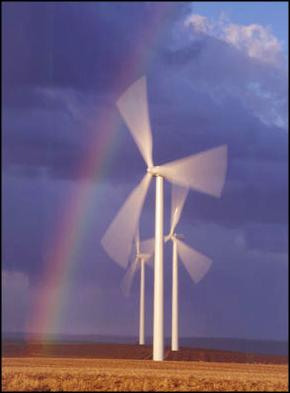 The number of jobs in America’s emerging clean energy economy grew nearly two and a half times faster than overall jobs between 1998 and 2007, according to a report (PDF) released last week by The Pew Charitable Trusts. The report also found that this promising sector is poised to expand significantly, driven by increasing consumer demand, venture capital and government infusions of cash, and federal and state policy reforms.
The number of jobs in America’s emerging clean energy economy grew nearly two and a half times faster than overall jobs between 1998 and 2007, according to a report (PDF) released last week by The Pew Charitable Trusts. The report also found that this promising sector is poised to expand significantly, driven by increasing consumer demand, venture capital and government infusions of cash, and federal and state policy reforms.
Pew found the count of the actual jobs in the clean energy economy grew at a national rate of 9.1 percent, while traditional jobs grew by only 3.7 percent between 1998 and 2007. Across all 50 states green job growth outperformed overall job growth in 38 states and the District of Columbia.
The report finds that the emerging clean energy economy is creating well-paying jobs in every state for people of all skill levels and educational backgrounds. Included in Pew’s definition are jobs as diverse as engineers, plumbers, administrative assistants, construction workers, machine setters, marketing consultants, teachers and many others, with annual incomes ranging from $21,000 to $111,000.
By 2007, the green economy had grown despite a lack of sustained government support — more than 68,200 clean energy businesses across all 50 states and the District of Columbia accounted for about 770,000 jobs. (By comparison, the well-established fossil-fuel sector—including utilities, coal mining and oil and gas extraction, industries that have received significant government investment—comprised about 1.27 million workers in 2007.)
“The clean energy economy is poised for explosive growth,” said Lori Grange, interim deputy director of the Pew Center on the States. “These jobs in wind, solar, geothermal and renewables are driving economic growth and environmental sustainability at a time when America needs both. There is a potential competitive advantage for federal and state policy leaders who act now to spur jobs, businesses and investments in the clean energy sector.”
The private sector views the clean energy economy as a significant and expanding market opportunity. Venture capital investment in clean technology crossed the $1 billion threshold in 2005 and continued to grow substantially, reaching a total of about $12.6 billion by the end of 2008. In 2008 alone, investors directed $5.9 billion into American businesses in the clean energy economy, a figure that represents a 48 percent increase over 2007 investment totals and accounts for 15 percent of all global venture capital investments.
Federal and state lawmakers also see the sector as helping to spur America’s economic recovery and protect the environment. States will receive a major infusion of federal funds through the recently enacted American Recovery and Reinvestment Act, which allocates nearly $85 billion in direct spending and tax incentives for energy- and transportation-related programs. Additionally, every state offers some form of financial incentive to drive its clean energy economy. Twenty-three states have adopted regional initiatives to reduce the global warming pollution from power plants, 46 states offer some form of tax incentive to encourage residents and corporations to use renewable energy or adopt energy efficiency systems and equipment, and 29 states and the District of Columbia have established renewable portfolio standards, which require electricity providers to supply a minimum amount of power from renewable energy sources.
“There is bipartisan support and a growing market demand for transitioning to the clean energy economy,” said Phyllis Cuttino, director, U.S. Global Warming Campaign, at the Pew Environment Group. “Americans understand the transition is good for the overall economy, is creating new opportunities for jobs and business growth, and helps protect our national security by reducing our dependence on foreign oil. Congress and the Obama Administration can and must produce energy and global warming legislation that creates jobs, enhances energy independence and sustains our environment.”



















